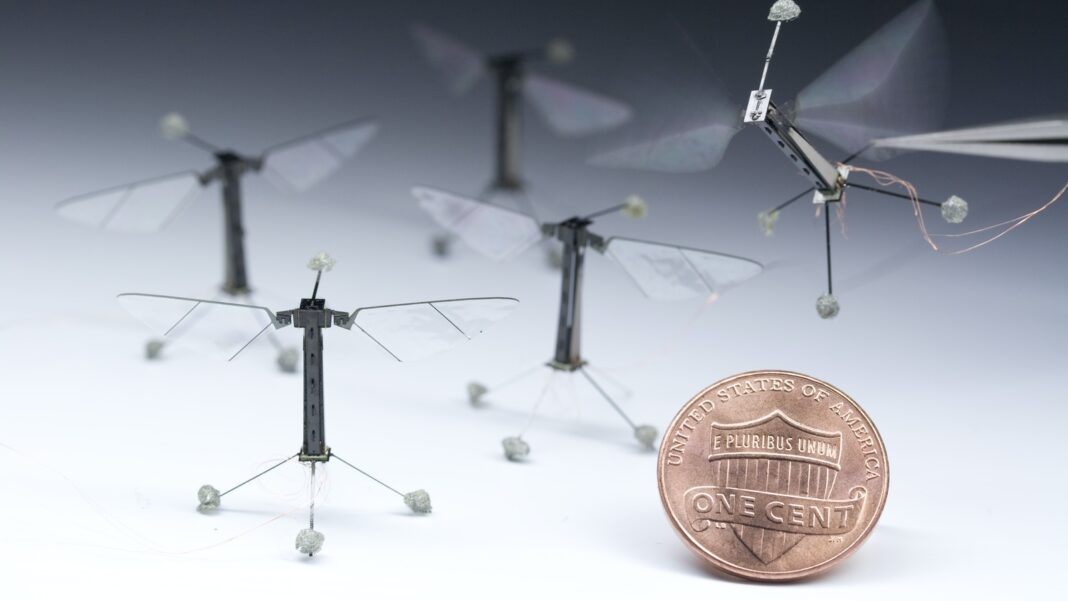The declining population of pollinating insects is a worldwide problem. Insects are dying out because of people. They pollute the air, destroy green areas and use dangerous pesticides. In many places, pollinating insects have completely disappeared. The best solution would be to eliminate the factors that kill pollinating insects. This seems to be an impossible task, given the growing population of people. Scientists from around the world are inventing robots that can replace bees and other pollinating insects.
Robotic bees
Researchers at the Wyss Institute are developing RoboBees. They are about half the size of a paper clip and weigh only one tenth of a gram. RoboBees flies using “artificial muscles” compromised of materials that contract when a voltage is applied. The goal is to develop autonomous miniature robots that are able to work together in a coordinated manner. The robot’s body mimics the body of a bee. There are sensors that respond to the environment and wings that allow you to fly.
“This is a result of several decades in the making,” said Robert Wood, Ph.D., Core Faculty member of the Wyss Institute, the Charles River Professor of Engineering and Applied Sciences at SEAS, and the principle investigator of the Robobee project. “Powering flight is something of a Catch-22 as the tradeoff between mass and power becomes extremely problematic at small scales where flight is inherently inefficient. It doesn’t help that even the smallest commercially available batteries weigh much more than the robot. We have developed strategies to address this challenge by increasing vehicle efficiency, creating extremely lightweight power circuits, and integrating high efficiency solar cells. ”
Researchers have used innovative manufacturing methods
To construct RoboBees, researchers at the Wyss Institute have developed innovative manufacturing methods, so-called Pop-Up microelectromechanical (MEMs) technologies.

To achieve untethered flight, this latest iteration of the Robobee underwent several important changes, including the addition of a second pair of wings. “The change from two to four wings, along with less visible changes to the actuator and transmission ratio, made the vehicle more efficient, gave it more lift, and allowed us to put everything we need on board without using more power,” said Jafferis. (The addition of the wings also earned this Robobee the nickname X-Wing, after the four-winged starfighters from Star Wars.)

That extra lift, with no additional power requirements, allowed the researchers to cut the power cord – which has kept the Robobee tethered for nearly a decade – and attach solar cells and an electronics panel to the vehicle.
The solar cells, the smallest commercially available, weigh 10 milligrams each and get 0.76 milliwatts per milligram of power when the sun is at full intensity. The Robobee X-Wing needs the power of about three Earth suns to fly, making outdoor flight out of reach for now. Instead, the researchers simulate that level of sunlight in the lab with halogen lights. The solar cells are connected to an electronics panel under the bee, which converts the low voltage signals of the solar array into high voltage drive signals needed to control the actuators. The solar cells sit about three centimeters above the wings, to avoid interference.

In all, the final vehicle, with the solar cells and electronics, weights 259 milligrams (about a quarter of a paper clip) and uses about 120 milliwatts of power, which is less power than it would take to light a single bulb on a string of LED Christmas lights.
Harvard has developed a portfolio of intellectual property (IP) related to the fabrication process for millimeter-scale devices. This IP, as well as related technologies, can be applied to microrobotics, medical devices, consumer electronics and a wide range of complex electromechanical systems. Harvard’s Office of Technology Development is exploring opportunities for commercial impact in these fields.

This research was co-authored by Michael Karpelson, Ph.D., Staff Electrical Engineer on the Institute’s Advanced Technology Team. It was supported by the National Science Foundation and the Office of Naval Research.
StickBug – New robotic pollinator
Robotic bees are not the only project to compensate for the loss of pollinating insects. Researchers at West Virginia University have come up with a plan B to this decline in pollinators by creating a robotic pollinator. A team led by Yu Gu, associate professor in the Department of Mechanical and Aerospace Engineering, is creating StickBug. It is a robot that has six arms and can efficiently pollinate different types of crops.
“It (StickBug) maps out the environment and once the robot has a general idea of the environment, it will build up a more detailed mapping of the plants and knows where the flowers are and which flower needs to be pollinated,” Gu said. “It will make a plan on what to do. Then, it will get close to each of the plants, start swinging its six arms and start pollinating. ”
The robot uses its arms to be able to pollinate flowers in hard-to-reach places. He can grab the branches, move them to the side and use other arms for pollination.
“The focus of the end product is to try to lower the barrier of entry to make it more practical so that growers would want to adopt a robotic technology in their greenhouse operation,” Gross said.
The robot should not only be able to pollinate different types of crops, but also collect important information about crops. About 80% of all plants need the help of animals to be able to pollinate. This is a project that should be able to keep agriculture running even when there is a shortage of pollinating insects.
Sources:
https://wyss.harvard.edu/technology/robobees-autonomous-flying-microrobots/
https://wvutoday.wvu.edu/stories/2021/10/27/wvu-researchers-develop-new-robot-pollinator-as-a-backup-for-declining-insect-populations
Image credit:
Wyss Institute at Harvard University
WVU Robotics

















